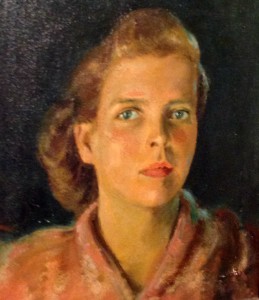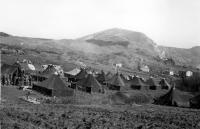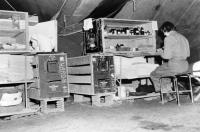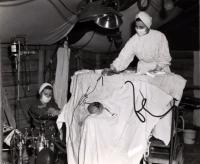1st Lieutenant Dorothy Sandridge, Nurse Anesthetist
John L. Guerrant | Hubert B. Holsinger | Alice M. Huffman | Frank L. Lowther | Randal Luscombe | Dorothy Sandridge | Melvin C. Shaffer | William P. Snavely | Beverley D. Tucker | Frances E. Wells | 8th EVAC home
Born on January 5th, 1920, at her grandfather’s farm in Albemarle County, Virginia, Dorothy Sandridge grew up in Charlottesville and attended two colleges in Virginia for a year each, first Randolph Macon Women’s College and then Mary Washington College. Her mother died when she was at Mary Washington, a decade following the death of her father. She decided not to return to the college, but chose to go to nursing school. She had worked in the Record Room at the University of Virginia Hospital in the summers and consequently was familiar with the hospital environment. She took the three year nursing course at the University of Virginia and graduated in 1942.
She remembers being a student working in the Delivery Room when Pearl Harbor was bombed on December 7, 1941, and immediately knew this would have far-reaching implications. Sandridge volunteered for the hospital unit that was being formed by the University to serve in the war. At first she was not selected as Ruth Beery was eager to have nurses with more experience. However, as the summer of 1942 wore on, Sandridge was accepted because the need for nurses was great. She knew she was chosen when she was told to report to the nurses’ quarters at the University Hospital with the comment, “You are being relieved of duty.”
She packed, bought a ticket, and was seen off by family and friends at the train station in the late summer of 1942. As she was traveling south to report to Fort Benning, Georgia, she met other people with the same orders. Four or five of them decided to stop and stay overnight in Augusta, Georgia, to see the sights. The next morning they found out they were AWOL before even arriving at their first post because they had not reported immediately. Captain Beery forcefully delivered a reprimand.
Once they were at Fort Benning, Sergeant Fletcher Spann, who would work in the laboratory at the 8th Evac Hospital, was assigned to teach them marching routines. These were never used in Africa or Italy, but the nurses did stand at attention over the course of the war for visiting dignitaries, including King George VI of England.
In Italy, Sandridge was sent to work in the sterilizing room because of her perceived inexperience. One day she saw a sign on a bulletin board seeking nurses who wanted to train to be a nurse anesthetist. Bored in the sterilizing room, she signed up, and in a couple weeks Captain Linus Miller, who worked as an anesthesiologist in Atlanta after the war, taught her how to start IVs, give infusions and endotracheal anesthesia, and administer ether and nitrous oxide. She gratefully traded her duties in the sterilizing room for the operating room.
In March 1944, the 8th Evac was stationed about 40 miles from Mt. Vesuvius, and its eruption on the 18th made a vivid impression on Sandridge. Another intense memory and her most frightening one occurred closer to the end of the war when she was sent to a forward echelon station. Rather than transport 40 dying patients to the hospital, it was decided to move 20 hospital staff members, including Sandridge with her nurse anesthetist training, to them. The best the 8th Evac staff could do for the mortally injured patients was to give them fluids and pain medicine. In the first 24 hours a shell went through the cot of fellow nurse Hilda Franklin who fortunately was not in it at the time. (Later married in Italy to Captain Richard P. Bell, 1st Lieutenant Franklin wore a wedding dress made out of a silk parachute.) After a week, Major Shine Holsinger realized Sandridge, the youngest nurse in the 8th Evac, was traumatized by the experience so close to the front and sent her back to the relative safety of the 8th Evacuation Hospital.
Shortly after that harrowing week, the war in Europe ended. However, Sandridge was not released from service because her skill as a nurse anesthetist made her a likely candidate to serve in the Pacific. After the atomic bombs were dropped in Japan in August 1945, she was allowed to return to the states.
One of the items that Sandridge brought back to the states was the portrait that the Italian, Eugenio Amadori, painted of her. Sandridge remembered him coming to the 8th Evac, desperate for work because he was on the verge of starvation. He was hired and did whatever needed to be done that he was able to do in addition to painting portraits.
After the war, Dr. E. Cato Drash, the last commanding officer of the 8th Evac, contacted Sandridge and asked if she would assist him as his anesthetist at the Blue Ridge Sanatorium outside of Charlottesville where he was doing open chest surgery on tuberculosis patients. Unafraid of contracting tuberculosis herself, she joined him in the operating room where lobectomies helped many with tuberculosis get well.
After working a few years in Charlottesville, Sandridge moved to Cleveland, Ohio, for more training. There, she met her future husband, Wilber Gloor. She was married in 1949 with fellow 8th Evac nurse Sue Hornberger as her maid of honor, had a daughter, eventually returned to work, and lived in Connecticut and Massachusetts before returning with her husband to retire in Charlottesville. She died in Charlottesville in 2016 at the age of 96.
The section above is a result of several interviews in February and March 2013.
Dorothy Sandridge Gloor wrote the following recollection in preparation for a talk to describe her time in the service from September 1942 through December 1943.
I was commissioned a 2nd lieutenant in September 1942 and served until February 1946. I was stationed at Fort Benning, Georgia; then Camp Kilmer, New Jersey; and Halloran General Hospital, Staten Island, New York. I spent six months in Africa divided between Casablanca in French Morocco and Cape Matafou which was across an inlet from Algiers, Algeria, on the Mediterranean Sea.
8th Evac camp at Goat Hill, Algeria
September 9, 1943. The news came of the surrender of the Italian Army and of our assignment to the troop invasion of Italy. At this time, we were camped at a staging area called “goat hill” outside of Oran, Africa. It rained continually, and there was no way to keep dry except when we were in our cots at night. The mud was only a preview of what was in store for us in Italy in the next two years.
September 15. At 1730 hours we entrucked and were taken to Mers-el-Kebir, a port town in northwestern Algeria, where we boarded the Durban Castle, a British transport, in pouring rain. Our quarters were converted staterooms with bunk beds that were much more comfortable than pyramidal tent living. The British served a lot of cabbage in their mess so we had some form of it in every meal except for breakfast. We remained in harbor for two days with other ships all around us.
September 17. At 1730 hours we finally got underway, leaving the mountain peak Djebel Khar with “goat hill” behind it in golden sunlight as we sailed by. We headed out into the Mediterranean Sea at 1930 hours, leaving the lights of Arzew, an Algerian port city, and of Africa to the Arabs. During our voyage, some of the personnel were ill with cramps and dysentery. Our water was restricted in use so this was a hardship for some.
September 20. Eleven days after the invasion of Italy, all of us slept fully clothed in anticipation of landing.
September 21. At 0400 hours we were up and ready to disembark. In order to get into the LCI (Landing craft, Infantry) to go ashore we had to go over the side of our ship with full field equipment on our backs and climb down a 50 foot rope ladder to the deck of a bobbing LCI boat below. We went ashore at Blue Beach (the Fifth Army designation for it). Barracks bags and bedrolls were taken to the bivouac area assigned to our unit.
We marched an hour or more and waited for trucks. There were foxholes all around us and damaged equipment from recent fighting. Knocked-out German tanks and trucks bore evidence of a recent, hard struggle during the landing at Salerno Beach. Soldiers milled around, and there seemed to be little of the military order we had been accustomed to. The army trucks came and we rode to our bivouac area. On the way, a group of soldiers spotted us and yelled to each other, “They are women!” It was the first of many times when our presence as female nurses seemed to be a “sight for sore G.I. eyes.” That night we slept on the ground with the sky as our only cover. The damaged wing of a German plane leaning against a tree provided a shield for the nurses to go to the latrine. We ate cold K rations and slept under the stars. Ruth Beery, our chief nurse nicknamed “chiefie,” came during the night with a blanket for some of us. She had been able to requisition some. Our 8th Evacuation group was clever at requisitioning things. It helped a lot.
September 22. We were informed that the SS William W. Gerhard had been torpedoed and sunk off the coast near Paestum, Italy. All of our hospital equipment was lost. We moved near Paestum with our pup tents. Imagine taking a bath with your helmet full of water inside a pup tent to shield you from the world. At times, two nurses shared a tent. We could hear artillery fire overhead.
September 25. We acquired some pyramidal tents which were large enough for four nurses. The folks in Charlottesville and at the University of Virginia began a collection to reequip our hospital because we were specifically affiliated with the University of Virginia and they cared about us.
September 26. This was my first experience with daylight savings time. We set our watches back an hour so darkness began at 1800 hours and daylight at 0530.
September 28. We were beginning to feel settled into our pyramidal tents, but at 2100 hours the swirling of a coastal tornado accompanied by torrential rain blew down our tents. Many pup tents of the enlisted men were blown away. I was inside a tent with some others. We desperately tried to steady the center pole but it finally toppled on us. Everything was soaked and mud covered. All the tents of the 16th Evacuation Hospital across the road from us went down like ten pins. Some patients were blown out into the road. Clothes and materiel were scattered all over the area. For the rest of the night our nurses were trucked to a building occupied by air corps officers. They gallantly provided us with stimulant. Space was limited, and as I remember it, I curled up after I was dry and slept on the barroom floor. We had a great treat of fresh eggs for breakfast. Our normal fare was only powdered eggs.
September 29. Our Commanding Officer, Colonel John McKoan, learned from General Blesse that the 8th Evacuation Hospital was to be sent back to Africa to reequip. Colonel McKoan was able to persuade the General to change his decision.
September 30. Our cooks purchased a water buffalo, and we had stew for supper.
October 1, 1943. Naples fell to the Allies. We got ready to use our gas masks as there were rumors of the Germans using gas as they withdrew. They wrecked and blew up everything they couldn’t carry with them. The post office in Naples was booby-trapped, and when the bomb went off, many Italians were hurt and over 100 killed.
Sterilizing room entrance into operating room at 8th Evac
October 2. Nine German prisoners were treated in our dispensary. They were our first patients in Italy. Our 8th Evacuation Hospital had 16 medical officers, 22 nurses, and 55 enlisted men who took over the care of patients. The patients suffered mostly from malaria, catarrh jaundice, dysentery, respiratory infections, and sandfly fever. Sanitary “shock troops” were sent into the conquered city of Naples to start repairs on the destruction of the water and sewage facilities.
October 3. Of the 1000 patients who were left victim to the elements five days earlier, 780 were moved into a tobacco warehouse with the drying tobacco still hanging in Paestum, Italy.
October 13. We moved to Caserta, Italy, where we set up in the only building we were to inhabit while in Italy.
November 1943. Small groups of us were sent on Detachment Service to a station hospital. The nurses’ quarters were in a bedbug-infested former Italian barracks. Fortunately, we were there only a few days. One of my friends came down with poliomyelitis. She and I were sent back to our hospital where she was placed in contagion. I nursed her until November 8th when she was sent back to the United States. After about four years of rehab, she walked with a cane.
November 9. Air raids continued to be frequent. Strict blackouts were observed. Sometimes we had more than one raid each night. Three German prisoners of war were admitted. Through begging, borrowing, and forced requisitioning we were now pretty well reequipped. This time had been well spent.
November 11. We celebrated Armistice Day with enough spit and polish to elicit praise even from the regular army people who visited frequently. We also celebrated Thomas Jefferson’s birthday on April 13th. We were always looking for reasons to celebrate, you might say. Because of continual cold and rain, some of our own personnel came down with pneumonia. This was before we had inoculations for this and for influenza.
8th Evac Ward boxes with supplies complete for a 40-bed ward
November 17. Our famous ward boxes built by our carpenters who were enlisted men were very much admired by visiting dignitaries.
November 19. Our capacity was 750 patients, but we now had 1,021.
November 25. It was business as usual except we had Thanksgiving turkey and apple pie (from cans).
December 15, 1943. At 1900 hour we were told to be ready to move on December 16th at 0730. Our new site was east of Teano, Italy.
December 17. We had to complete the road building ourselves in order for ambulances to reach us from the front. It was a constant battle to keep roads open due to the mud that was almost impassable by trucks or jeeps.
December 19. At 0800 the hospital opened with 203 patients admitted by midnight, mostly from the 3rd and 36th infantry divisions. Ninety-nine of these cases were already in shock, 33 cases were operated upon that day, and we were finally doing what we felt we had gone to war to do.
8th Evac operating tent, Sandridge giving anesthesia on the left
December 20. Casualties still poured in, surgery was running around the clock. As an anesthetist, I worked 16 hours on and 8 hours off around the clock.
December 21. Our first patient death was a battle casualty. Heavy artillery was active, the ground rumbled, and the sky flashed north of us. Two hundred and sixteen patients were admitted today.
December 24-25. Turkey and chocolate cake arrived. The mess sergeant baked pineapple pies, and we had enough of everything for 800 people. Our Red Cross women, Ruth Buffington and Frances Carter, got cigarettes and candy and wrapped them for each patient. We had a small, lighted tree in the American Red Cross day room. It was rainy, muddy, and clinically nasty. The rumbles of artillery made it even more fantastic. Thus passed our first Christmas, 1943, in Italy.
John L. Guerrant | Hubert B. Holsinger | Alice M. Huffman | Frank L. Lowther | Randal Luscombe | Dorothy Sandridge | Melvin C. Shaffer | William P. Snavely | Beverley D. Tucker | Frances E. Wells | 8th EVAC home





